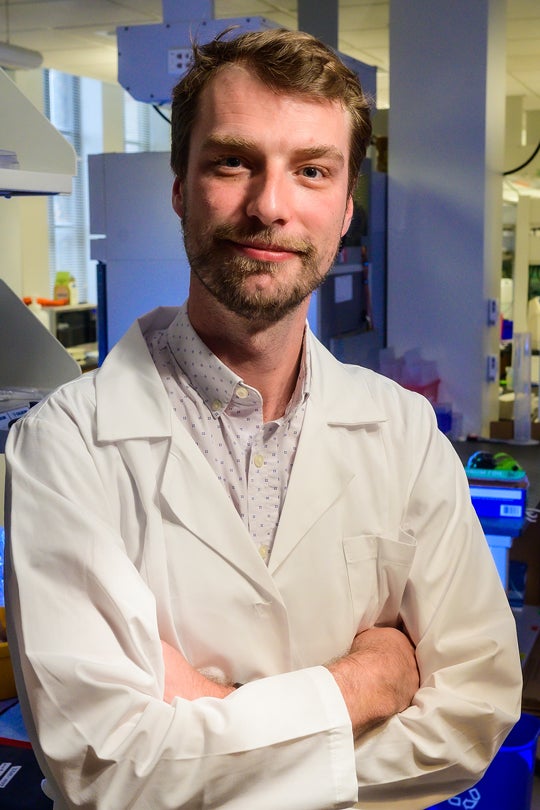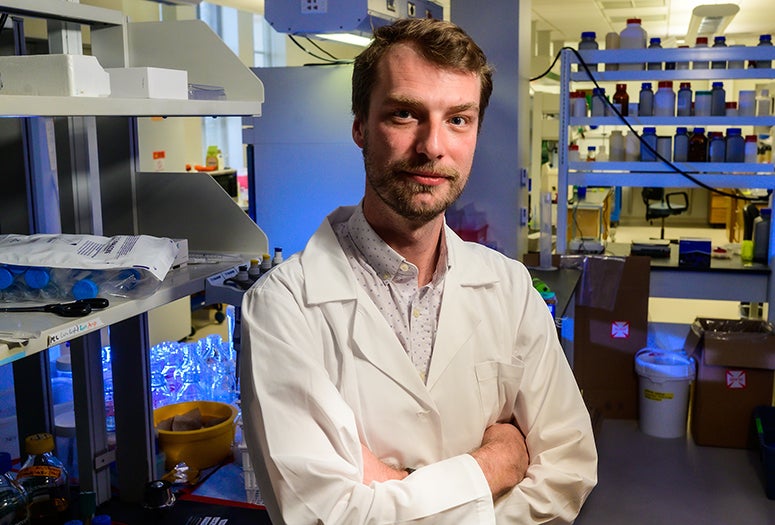Rice University bioscientist and synthetic biologist James Chappell has won a National Science Foundation CAREER Award to develop RNA programming methods to improve human health and the environment.
“Synthetic biology has progressed a lot in the past decade, and we’ve gotten really good at genetically programming microbes in confined laboratory environments where conditions are ideal,” said Chappell, an assistant professor both of biosciences and of bioengineering. “But, of course, most microbes on the planet don't live in pure cultures where the temperature is always 37 degrees (Celsius).

“With the CAREER, we’re trying to think about programming in more complex environments,” he said. “The question is, ‘Can we use the engineered RNA systems we’ve developed to start programming communities of microbes in more messy environments?’”
CAREER awards, the NSF’s most prestigious early-career honors, recognize young scientists who “have the potential to serve as academic role models in research and education.” Only about 500 CAREER Awards are given across all academic disciplines each year, and Chappell is one of nine Rice faculty to garner one in 2023.
Chappell, who joined Rice in 2017, researches RNA systems and biotechnologies. RNA, like DNA, are molecules made of long chains of nucleotides. Both DNA and RNA encode information based upon the sequence of nucleotides in their chains, but DNA is the medium cells use to store genetic information, and RNA is the medium for accessing and acting on that stored information. Cells also use RNA to turn genes on and off, catalyze chemical reactions, and sense molecular and environmental cues.
“As a discipline, synthetic biology has frameworks to genetically program model microbes in the laboratory,” he said. “We need analogous frameworks to program the native microbial communities that are all around us in soils, rivers, our built environment and even our own bodies.”
Microbial communities are groups of microbes, like bacteria, that share a common living space and either coexist peacefully or and work together in symbiotic partnership.
“Microbial communities are found almost everywhere, and they underlie processes that are critical for humans,” Chappell said.
For example, microbial communities in our intestines help digest food. Microbial communities called biofilms can damage surfaces like the enamel on our teeth or the finishes on our buildings. And on a larger scale, Chappell said microbial communities play critical roles in agriculture, sewage treatment and ecosystem health.
“Having the ability to genetically manipulate such communities will allow us to study and better understand them,” he said. “We could also program them with new or improved functions that improve human health, crop yields and global sustainability.”
For example, Chappell and Rice Biosciences colleague Joff Silberg recently won a three-year grant from the Kleberg Foundation to create RNA programs that will act as “genetically encoded antibiotics.” The idea is for individual bacteria to readily copy and share the antibiotic programs, which will selectively kill disease-causing bacteria thanks to a triggering mechanism that recognizes “virulence genes” or other pathogen-specific biomarkers.
In the CAREER research, Chappell’s lab will focus on creating a new method for genetically programming microbial communities that live in soil, wastewater and other messy environments.

Engineered RNA systems will be used in the laboratory to study how various genetic programs propagate through “undomesticated” microbial communities in such complex media. Chappell’s team will work to implement spatiotemporal control in these environments, creating genetic programs that can be selectively activated at specific times or in specific places.
“After we develop these methods, we plan to combine and apply them in a proof-of-concept demonstration where we’ll use RNA programming to enhance the ability of a microbial community to harvest clean energy directly from human or animal waste,” Chappell said.
The project research will be integrated with an educational plan that will bring community college students into the lab to take an active role in the research so they can decide if they are interested in pursuing an advanced degree or career in science, technology, engineering or mathematics.
Chappell said there are advantages to developing an RNA-based technology for programming microbial communities.
“RNA is a very versatile molecule in terms of functionality,” he said. “If we invest time and figure out how to program with it, it’s likely we’ll be able to write programs that do a lot of different things. We also expect RNA programming to be functionally portable, meaning it can work in a lot of diverse contexts. That’s big for us, because we’re thinking about how to program complex communities of microbes, and functional portability means an RNA program that works in one messy environment has a good chance of working in another.”
Chappell said there’s also a good chance the team could eventually use artificial intelligence or other computational techniques to automate the design of microbial programming.
“The design rules for RNA are pretty simple,” he said. “A lot of the systems we work with depend on two RNA molecules coming together. How they interact when they come together is based on the simple rules of Watson-Crick base-pairing, where A (adenine) pairs with T (thymine) and G (guanine) pairs with C (cytosine). It’s super simple, which means there’s a good chance we can learn it well enough to create computational algorithms that predict and design RNA function directly from sequence.”
- Grant information
-
“CAREER: Selective activation of catalytic RNA to control energy flow in microbial consortia” | NSF Division of Molecular and Cellular Bioscience
- Image downloads
-
https://news-network.rice.edu/news/files/2023/03/0327_CHAPPELL-Fit3-lg.jpg
CAPTION: James Chappell (Photo by Jeff Fitlow/Rice University)https://news-network.rice.edu/news/files/2023/03/0327_CHAPPELL-Fit5-lg.jpg
CAPTION: James Chappell (Photo by Jeff Fitlow/Rice University)https://news-network.rice.edu/news/files/2023/03/0327_CHAPPELL-Fig-lg.jpg
CAPTION: James Chappell’s research group at Rice University uses RNA technologies to transfer genetic programs between individual microbes in order to control and program communities of microbes that coexist or work together in a common living space. Chappell won a National Science Foundation CAREER Award that includes a five-year research grant for his lab to investigate renewable energy applications of RNA programs that selectively control the flow of energy in microbial consortia. - Related stories
-
Rice team eyes cells for sophisticated data storage – Aug. 18, 2022
https://news.rice.edu/news/2022/rice-team-eyes-cells-sophisticated-data-storageRice bioscientist Chappell awarded Sloan Research Fellowship – Feb. 15, 2018
https://news2.rice.edu/2018/02/15/rice-bioscientist-chappell-awarded-sloan-research-fellowship/ - Links
-
Chappell Lab: https://www.chappell-lab.org
Rice Department of BioSciences: https://biosciences.rice.edu
Wiess School of Natural Sciences: https://naturalsciences.rice.edu/
George R. Brown School of Engineering: https://engineering.rice.edu/
- About Rice
-
Located on a 300-acre forested campus in Houston, Rice University is consistently ranked among the nation’s top 20 universities by U.S. News & World Report. Rice has highly respected schools of Architecture, Business, Continuing Studies, Engineering, Humanities, Music, Natural Sciences and Social Sciences and is home to the Baker Institute for Public Policy. With 4,240 undergraduates and 3,972 graduate students, Rice’s undergraduate student-to-faculty ratio is just under 6-to-1. Its residential college system builds close-knit communities and lifelong friendships, just one reason why Rice is ranked No. 1 for lots of race/class interaction and No. 1 for quality of life by the Princeton Review. Rice is also rated as a best value among private universities by Kiplinger’s Personal Finance.

